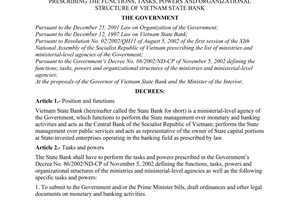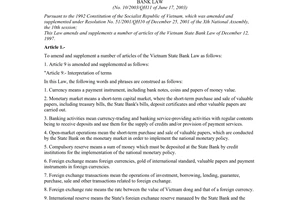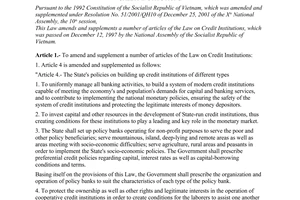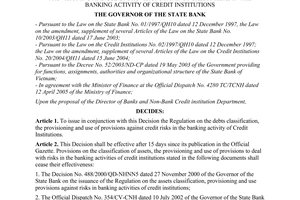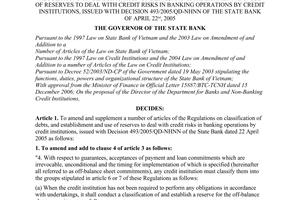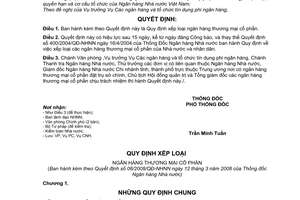Decision No. 06/2008/QD-NHNN of March 12, 2008, promulgating the regulation on rating of joint stock Commercial Banks. đã được thay thế bởi Circular 52/2018/TT-NHNN credit rating of credit institutions and foreign bank branches và được áp dụng kể từ ngày 01/04/2019.
Nội dung toàn văn Decision No. 06/2008/QD-NHNN of March 12, 2008, promulgating the regulation on rating of joint stock Commercial Banks.
|
THE
STATE BANK OF VIETNAM |
SOCIALIST
REPUBLIC OF VIET NAM |
|
No. 06/2008/QD-NHNN |
Hanoi, March 12, 2008 |
DECISION
PROMULGATING THE REGULATION ON RATING OF JOINT STOCK COMMERCIAL BANKS
THE STATE BANK GOVERNOR
Pursuant to the 1997 Law on
the State Bank of Vietnam and the 2003 Law Amending and Supplementing a Number
of Articles of the Law on the State Bank of Vietnam;
Pursuant to the 1997 Law on Credit Institutions and the 2004 Law Amending and
Supplementing a Number of Articles of the Law on Credit Institutions;
Pursuant to the Governments Decree No. 52/2003/ND-CP of May 19, 2003, defining
the functions, tasks, powers and organizational structure of the State Bank of
Vietnam;
At the proposal of the Director of the Department of Banks and Non-Bank Credit
Institutions,
DECIDES:
Article 1. To promulgate together with this Decision the Regulation on rating of joint stock commercial banks.
Article 2. This Decision takes effect 15 days after its publication in CONG BAO and replaces the State Bank Governors Decision No. 400/2004/QD-NHNN of April 16, 2004, promulgating the Regulation on rating of state-run and people-founded joint stock commercial banks.
Article 3. The director of the Office, the director of the Department of Banks and Non-Bank Credit Institutions, the chief inspector of the State Bank, heads of concerned units under the State Bank, directors of the State Banks branches in provinces and centrally run cities where the head offices of joint stock commercial banks are located, chairmen of Boards of Directors and directors of joint stock commercial banks shall implement this Decision.
|
|
FOR THE STATE
BANK GOVERNOR |
REGULATION
ON RATING OF JOINT STOCK COMMERCIAL BANKS
(Promulgated together with the State Bank Governors Decision No.
06/2008/QD-NHNN of March 12, 2008)
Chapter I
GENERAL PROVISIONS
Article 1. Governing scope and subjects of application
This Regulation applies to joint stock commercial banks which are permitted to be established and operate in Vietnam in accordance with the Law on Credit Institutions.
Article 2. Rating indicators
1. Equity.
2. Asset quality.
3. Management capability.
4. Business performance.
5. Liquidity.
Article 3. Assessment and rating method
1. The assessment and rating of joint stock commercial banks shall be based on the scores obtained under each indicator specified in Article 2 of this Regulation.
2. The scoring principle is to subtract the deducted points under each indicator from maximum points. Joint stock commercial banks which do not provide business activities as specified in this Regulation will be given no point for the indicator of such business activities.
3. Data used for scoring are based on:
a/ Data in the balance sheet (tier III, tier IV, tier V), reported statistical data of joint stock commercial banks;
b/ Data from the inspection and supervision by the State Bank (off-site supervision data, inspection conclusions);
c/ Other related documents such as reports from independent auditors, management letter from independent auditors, internal audit reports of joint stock commercial banks;
d/ Data in financial statements of joint stock commercial banks in the year of rating audited by independent auditors.
4. The structure of scores under various indicators and total scores for assessment and rating:
a/ The maximum total of scores for rating a joint stock commercial bank is 100 points.
b/ Structure of scores under each rating indicator is specified as follows:
- Equity: Maximum is 15 points, minimum is minus 3 points;
- Asset quality: Maximum is 35 points, minimum is 0 point;
- Management capability: Maximum is 15 points, minimum is 0 point;
- Business performance: maximum is 20 points, minimum is 0 point;
- Liquidity: Maximum is 15 points, minimum is 0 point.
Article 4. Interpretation of terms
In this Regulation, the terms below are construed as follows:
1. Total outstanding loan balance: consists of normal outstanding loans and outstanding loans paid on behalf of customers.
2. Total non-performing loans: means the sum of loans under groups 3, 4 and 5 as specified in Clause 3, Article 1 of the State Bank Governors Decision No. 18/2007/QD-NHNN of April 25, 2007, amending and supplementing a number of articles of the Regulation on classification of debts, deduction for setting up, and use of provisions for offsetting credit risks in credit institutions banking activities, promulgated together with the State Bank Governors Decision No. 493/2005/QD-NHNN of April 22, 2005, or Article 7 of the Regulation on classification of debts, deduction for setting up, and use of provisions for offsetting credit risks in credit institutions banking activities, promulgated together with the State Bank Governors Decision No. 493/2005/QD-NHNN of April 22, 2005.
3. Non-performing loan ratio: means the ratio of total non-performing loans to total outstanding loan balance.
4. Equity includes tier-1 capital (to ensure the limit upon identification of tier-1 capital) plus tier-2 capital (to ensure the limit upon identification of tier-2 capital) and subtract all items to be deducted from equity as specified in Article 3 of the Regulation on safety ratios in credit institutions activities, promulgated together with the State Bank Governors Decision No. 457/2005/QD-NHNN of April 19, 2005, and Clause 3, Article 1 of the State Bank Governors Decision No. 03/2007/QD-NHNN of January 19, 2007, amending and supplementing a number of articles of the Regulation on safety ratios in credit institutions activities, promulgated together with the State Bank Governors Decision No. 457/2005/QD-NHNN of April 19, 2005.
5. Owners equity: means an item reflected on the balance sheet of joint stock commercial banks in the year of rating audited by independent auditors.
6. Pre-tax profit: means an item reflected on the business performance report of joint stock commercial banks in the year of rating audited by independent auditors. Pre-tax profit is calculated by subtracting operating expenses and provisions set up in the year from operating income and adding recovered credit risk provisions within the year.
In case a joint stock commercial bank has not yet set up sufficient risk provisions, the item of pre-tax profit in the business performance report should be adjusted by subtracting the insufficient risk provision as per conclusion of the State Banks Inspectorate and/or report of an independent auditor, management letter to compute relevant ratios and rate joint stock commercial banks.
7. Average owners equity is calculated using the following formula:
In which:
+ is average owners equity of the year of rating;
+ Y0 is the owners equity as of December 31 of the year preceding the rating year (or the first day of January of the rating year) reflected in the balance sheet as of December 31 of the year preceding the rating year audited by an independent auditor;
+ Y1, Y2, Y3 is the owners equity as of March 31, June 30, and September 30 of the rating year, respectively;
+ Y4 is the owners equity as of December 31 of the rating year reflected in the balance sheet as of December 31 of the rating year audited by an independent auditor.
8. Earning assets: means the total of asset items that can bring about returns for the credit institution as of December 31 of the rating year, consisting of the following categories on the consolidated balance sheet of joint stock commercial banks audited by an independent auditor: money and gold deposited in other credit institutions, loans to other credit institutions: trading securities; loans to customers: investment securities; capital contribution, long term investment; real estate for investment purposes.
9. Off-balance sheet commitments include irrevocable unconditional guarantees, payment acceptance and loan commitments with specific time schedule for implementation.
10. Off-balance sheet commitment quality ratio means the ratio of total balance of off-balance sheet commitments under group 3, 4, and 5 as defined at Clauses 1 and 3, Article 1 of Decision No. 18/2007/QD-NHNN of April 25, 2007, or Article 7 of the Regulation on classification of debts, deduction for setting up, and use of provisions for offsetting credit risks in credit institutions banking activities, promulgated together with the State Bank Governors Decision No. 493/2005/QD-NHNN of April 22, 2005, divided by total balance of off-balance sheet commitments.
11. Investments on balance sheet consist of the following items: trading securities, investment securities and capital contribution for long-term investment.
12. Material: is a term to reflect the importance of information (an accounting data) in financial statements. Information is considered material if the lack of such information or lack of accuracy of such information will impact decisions made by the person who uses such financial statements (Vietnam audit standard No. 320 promulgated together with Decision No. 28/2003/QD-BTC of March 14, 2003, of the Minister of Finance).
Chapter II
SPECIFIC PR004FVISIONS
Section 1. SCORING SCALE OF RATING INDICATORS
Article 5. Equity: The maximum score is 15 points, minimum is minus 3 points.
1. Joint stock commercial banks will attain the maximum score of 15 points when they meet the following conditions:
a/ Charter capital in the year of rating is not less than legal capital.
b/ Capital adequacy, specifically:
- The minimum capital adequacy ratio in the year of rating must meet the minimum level of 8% as regulated by the State Bank of Vietnam;
- Charter capital has been used in strict compliance with the State Banks regulations.
c/ The State Banks direction of encouraging effective capital increase is ensured.
2. Deducted points: maximum 18 points
a/ Charter capital is less than legal capital: 5 points to be deducted.
b/ Insufficient capital adequacy: maximum 8 points to be deducted.
- The minimum capital adequacy ratio is less than 8%: 4 points will be deducted upon violation of one of the following cases:
+ The average minimum capital adequacy ratio in the year of rating attains 8% or more but the minimum capital adequacy ratio in one or some months of such year is less than 8%;
+ The average minimum capital adequacy ratio in the year of rating is less than 8%.
- Charter capital has not been used in compliance with the State Banks regulations: 4 points will be deducted upon violation of one of the following cases:
+ Violation of the State Banks current regulations on the limit of capital contribution, purchase of shares (this must be stated at the conclusion of the Inspectorate of the State Banks branch in the city or province where the head office of the joint stock commercial bank is located, conclusion of the State Banks Inspectorate, report of an independent auditor);
+ Loss in business performance and no funds available but dividends are distributed to shareholders (use of charter capital);
+ Purchase of fixed assets exceeds 50% of equity;
+ Other violation regarding the use of charter capital.
c/ Failure to ensure the State Banks direction of encouraging effective capital increase: maximum 5 points to be deducted.
(i) The average minimum capital adequacy ratio in the year of rating is over 8% and no month in such year attaining less than 8%, and the ratio of pre-tax profit to average owners equity reaching from 14% to below 17%: 2 points will be deducted.
(ii) Joint stock commercial banks which do not fall within the following cases: (1) The average minimum capital adequacy ratio in the year of rating is over 8% and no month in such year attaining less than 8%, and the ratio of pretax profit to average owners equity reaching 17% and higher; (2) conditions specified at Point c.(i), Clause 2 of this Article: 5 points will be deducted.
Article 6. Asset quality: Maximum score is 35 points, minimum score is 0 point
1. Quality of loans and advances to customers and loans to other credit institutions: Maximum score is 20 points, minimum score is 0 point for joint stock commercial banks whose balance of loans and advances to customers and loans to other credit institutions is less than 50% of total assets; and maximum score of 25 points and minimum score of 0 point for joint stock commercial banks whose balance of loans and advances to customers and loans to other credit institutions account for 50% or more of total assets.
a/ To attain the maximum score in terms of quality of loans and advances to customers and loans to other credit institutions, joint stock commercial banks must ensure that:
- The non-performing loan ratio is equal or less than 3%;
- They comply with the State Banks Regulation on classification of debts, deduction for setting up and use of provisions for offsetting credit risks.
b/ In case joint stock commercial banks fail to meet one of the conditions specified at Point a, Clause 1 of this Article, its scores will be deducted as follows:
- The non-performing loan ratio is between over 3% and 5%: 10 points will be deducted from joint stock commercial banks whose balance of loans and advances to customers and loans to other credit institutions is less than 50% of total assets; or 13 points will be deducted from joint stock commercial banks whose balance of loans and advances to customers and loans to other credit institutions is equal to or more than 50% of total assets.
- The non-performing loan ratio is between over 5% and 10%: 15 points will be deducted from joint stock commercial banks whose balance of loans and advances to customers and loans to other credit institutions is less than 50% of total assets; or 19 points will be deducted from joint stock commercial banks whose balance of loans and advances to customers and loans to other credit institutions is equal to or more than 50% of total assets.
- The non-performing loan ratio is over 10% or fails to follow the State Banks Regulation on classification of debts, deduction for setting up and use of provisions for offsetting credit risks, which has impacted the reasonable integrity of the quality of loans and advances to customers and loans to other credit institutions in material terms of the financial statements of joint stock commercial banks in the year of rating audited by independent auditors (incorrect classification of debts and setting up of insufficient provisions have resulted in disqualification opinions of independent auditors reflected in management letter, report of independent auditor, or joint stock commercial banks being administratively sanctioned by the State Banks Inspectorate as stated in the conclusion of the State Banks Inspectorate in the year of rating): 20 points to be deducted from joint stock commercial banks whose balance of loans and advances to customers and loans to other credit institutions is less than 50% of total assets; or 25 points to be deducted from joint stock commercial banks whose balance of loans and advances to customers and loans to other credit institutions accounts for 50% or more of total assets.
2. Investment quality: Maximum score: 5 points, minimum score: 0 point
a/ A joint-stock commercial bank will attain maximum 5 points for investment quality indicator if the ratio of securities depreciation provisions to the total investment balance in the balance sheet does not exceed 1%, otherwise 5 points will be deducted.
b/ This Clause is not applicable to joint-stock commercial banks whose outstanding balance of loans and advances to customers and loans to other credit institutions accounts for 50% or more of their total assets.
3. Structure of on-balance sheet assets: maximum score: 5 points, minimum score: 0 point.
a/ The ratio of earning assets to the total on-balance sheet assets attains 75% or more: 5 points;
b/ The ratio of earning assets to the total on-balance sheet assets attains less than 75%: deduct maximum 5 points:
- From 65% to less than 75%: deduct 2 points;
- From 50% to less than 65%: deduct 3 points;
- Less than 50%: deduct 5 points.
4. Off-balance sheet commitment quality: Maximum score: 5 points, minimum score: 0 point.
a/ A joint-stock commercial bank will attain maximum 5 points for the indicator of off-balance sheet commitment quality if it satisfies the following conditions:
- The off-balance sheet commitment quality ratio is less than or equal to 3%;
- It complies with the State Banks regulations on loan classification, provision setting up and utilization for handling of credit risks of off-balance sheet commitments.
b/ A joint-stock commercial bank failing to meet one of the conditions stated at Point a, Clause 1 of this Article is subject to score deduction as follows:
- The off-balance sheet commitment quality ratio is between over 3% and 5%: deduct 3 points:
- The off-balance sheet commitment quality ratio is over 5% or the bank fails to comply with the State Banks regulations on classification of debts, deduction for setting up and use of provisions for offsetting of credit risks of off-balance sheet commitments, which has impacted the reasonable integrity of off-balance sheet commitment items in material terms of the financial statement of joint-stock commercial banks in the year of rating audited by an independent auditor (insufficient provision setting up has resulted in disqualification opinions of independent auditors in the management letter and independent auditors report or the joint-stock commercial bank is sanctioned by the State Banks Inspectorate for its administrative violations, which is shown in the conclusion of the State Banks Inspectorate for the year of rating): deduct 5 points.
Article 7. Management capacity: maximum score: 15 points, minimum score: 0 point
1. A joint-stock commercial bank will attain maximum 15 points if it satisfies the following conditions:
a/ Having an adequate number of members of the Board of Directors and Supervisory Board:
b/ Fully issuing, standardizing and observing internal regulations;
c/ The internal inspection and auditing system corresponds to the bank size and operates efficiently, ensuring that all major risks are identified, measured, inspected and controlled on a regular basis;
d/ Members of the Board of Directors, the Supervisory Board, the Board of Management are competent, unified, respectful to the laws, responsible and properly perform their tasks and exercise their powers in the management and control of the bank;
e/ Observing the State Banks regulations on shareholders, shares and stocks.
2. A joint-stock commercial bank failing to satisfy one of the conditions stipulated in Clause 1 of this Article is subject to score deduction as follows:
a/ A joint-stock commercial bank will be deducted 3 points when it fails to meet one of the following conditions:
- Not having enough members of the Board of Directors or the Supervisory Board according to the State Banks regulations and the Charter of the joint-stock commercial bank;
- Failing to issue fully and standardize internal regulations on the operation of the Board of Directors, the Supervisory Board and the Board of Management as well as other regulations necessary for the banks operation (credit, guarantee, accounting and other operations) or there are comments of the State Banks Inspectorate (in the Inspectorates conclusion of the year of rating) or of independent auditors (in the independent auditors report, management letter of the year of rating) that the banks internal procedures are ineffective, leading to restrictions on the inspection and auditing process.
b/ The internal inspection and auditing system is weak and operates inefficiently: 4 points will be deducted when there is one of the following indicators:
- Regarding organizational structure, the internal inspection and auditing system is neither under nor subject to direct guidance by the Supervisory Board and the salary, bonus and responsibilities allowance regime for the internal auditing division is decided by the Board of Management (the general director, deputy general director of the joint-stock commercial bank);
- The person in charge of the internal auditing division does not have professional qualification (bachelor level and higher) in finance-banking or accounting-auditing; fails to have 3-year work experience in the financial and banking sector;
- The joint-stock commercial bank fails to issue official regulations on internal auditing procedures for uniform application in the entire system or internal auditing procedures have been issued but are inefficient (the findings by internal auditing are fewer than or different from those stated in the independent auditors report and the conclusion of the State Banks Inspectorate, which has affected the reasonable integrity in material terms of the financial statement and the banks compliance with legal regulations.)
c/ Failing to satisfy the conditions stipulated at Point d, Clause 1 of this Article: deduct maximum 6 points:
- Lack of internal unity: deduct 3 points;
- A member of the Board of Directors, the Supervisory Board or the Board of Management violates regulations of the law and the State Bank (violates Articles 77 and 78 of the Law on Credit Institutions), fails to properly perform tasks and exercise powers in the governance, control and management of the bank, especially in guiding the implementation of regulations on safety of banking activities and statistical reporting of credit institutions promulgated by the State Bank Governor: deduct 3 points.
d/ Violating regulations on stockholders, shares and stocks: deduct 2 points when one of the following violations is committed:
+ The number of stockholders is not enough according to current regulations on stockholders, shares, stocks and charter capital of joint-stock commercial banks promulgated by the State Bank Governor;
+ Violating one of the following conditions: Stockholder records are incomplete; the representative is disqualified; contributed capital and stock holding limits set forth in current regulations on stockholders, shares, stocks and charter capital of joint-stock commercial banks promulgated by the State Bank Governor are violated;
+ Violating one of the following conditions: The issuance of stocks and management of stockholders do not comply with current regulations on stockholders, shares, stocks and charter capital of joint-stock commercial banks promulgated by the State Bank Governor.
3. If a joint-stock commercial bank is put under special control status, its score will be 0 for the indicator of governance, control and management.
Article 8. Business performance: maximum score: 20 points, minimum score: 0 point
1. Business performance: maximum 15 points:
a/ Business performance with profits, maximum 15 points:
- The ratio of pre-tax income to equity attains from 17% and more: 15 points;
- The ratio of pre-tax income to equity attains from 14% to less than 17%: 15 points;
- The ratio of pre-tax income to equity attains from 10% to less than 14%: 10 points;
- The ratio of pre-tax income to equity attains from 5% to less than 10%: 8 points;
- The ratio of pre-tax income to equity attains less than 5%: 5 points.
b/ Business performance in the period attains no profit: 0 score.
2. Reward score for services: maximum 5 points
a/ The ratio of income generated from services to total income: 3 points
- Attaining from 8% and higher: 3 points:
- Attaining from 2% to less than 8%: 1 point:
- Attaining less than 2%: 0 point.
b/ The ratio of net income generated from services to pre-tax income: 2 points
- Attaining 30% and more: 2 points:
- Attaining between 14% and less than 30%: 1 score;
- Attaining less than 14%: 0 score.
Article 9. Liquidity: Maximum score: 15 points, minimum score: 0 point
1. Current ratio = quick assets/current liabilities:
a/ A joint-stock commercial bank assuring a liquidity ratio in accordance with the State Banks regulations will attain maximum 12 points.
b/ A joint-stock commercial bank failing to assure a liquidity ratio in accordance with the State Banks regulations is subject to score deduction as follows:
- Failing to ensure the liquidity ratio once: deduct 5 points;
- Violating the regulations on liquidity ratio for several times, causing the State Bank to issue warnings or sanction the bank for administrative violations of the regulations on liquidity ratio: deduct 12 points.
2. Maximum ratio of short-term funds to long-term loans: To comply with the State Banks regulations.
a/ No violation of regulations on maximum ratio of short-term funds to long-term loans: 3 points.
b/ Violating regulations on maximum ratio of short-term funds to long-term loans once: deduct 2 points.
c/ Violating regulations on maximum ratio of short-term funds to long-term loans for several times: deduct 3 points
3. The assessment and rating based on this indicator may use daily/monthly average data according to the State Banks statistic and reporting regime.
Section 2. RATING
Article 10. Scoring
The total score of a joint-stock commercial bank is calculated by adding up all the points attained under each indicator under Articles 5, 6, 7, 8 and 9 of this Regulation.
Article 11. Rating of joint-stock commercial banks
1. A joint-stock commercial bank to be rated A must attain a total score of 80 points or more and its score for each indicator as stipulated in Articles 5, 6, 7, 8 and 9 of this Regulation must not be less than 65% of the maximum score stipulated for that indicator.
2. A joint-stock commercial bank to be rated B must attain a total score of between 60 and 79 points and its score for each indicator stipulated in Articles 5, 6, 7, 8 and 9 of this Regulation must not be less than 50% of the maximum score stipulated for that indicator; or attain a total score of more than 79 points but the score for at least one indicator must be between over 50% and less than 65% of the maximum score stipulated for that indicator.
3. A joint-stock commercial bank to be rated C must attain a total score of between 50 and 59 points and its score for each indicator stipulated in Articles 5, 6, 7, 8 and 9 of this Regulation must not be less than 45% of the maximum score stipulated for that indicator; or attain a total score of more than 59 points but the score attained for at least one indicator must be between over 45% and less than 50% of the maximum score stipulated for that indicator.
4. A joint-stock commercial bank to be rated D attains a total score of less than 50 points; or has a total score of more than 50 but the score attained for at least one indicator is below 45% of the maximum score stipulated for that indicator.
Article 12. Time frame for rating
1. The data to be used for evaluation and rating are based on the official accounting data of the year of rating of the joint-stock commercial bank which have been audited by an independent audit organization. Regarding the indicators on banking operation safety in particular, the data to be used for rating shall be based on the reporting data of the year of rating in accordance with current information and reporting regulations. The indicator of management capacity (Article 7) shall be rated for the entire fiscal year.
2. Time for evaluation and rating:
a/ Not later than May 10 of the subsequent year, each joint-stock commercial bank shall conduct self-rating and send the rating results to the State Banks branch of the province or centrally run city where its head office is located;
b/ Not later than May 31 of the subsequent year, the State Banks branch of the province or centrally run city shall give opinions on assessment of the self-rating results provided by the joint-stock commercial bank whose head office is located in the locality and submit consolidated results of rating to the State Bank (the State Banks Inspectorate);
c/ In June annually, the State Bank Governor shall approve the rating results of joint-stock commercial banks.
Chapter III
ORGANIZATION OF IMPLEMENTATION
Article 13. Responsibilities of joint-stock commercial banks
1. To provide true and accurate data in compliance with current information and reporting regulations. Should the reporting data of a joint-stock commercial bank be found incorrect after rating, the chairman of the Board of Directors, the chief of the Supervisory Board and the general director of the joint-stock commercial bank shall take full responsibility for that. The State Bank will re-announce the rating of that joint-stock commercial bank.
2. To conduct self-rating in accordance with the time frame allowed and a set form.
Article 14. Responsibilities of the State Banks branches of provinces or centrally run cities where head offices of joint-stock commercial banks are located
1. To supervise and urge joint-stock commercial banks to submit their self-rating reports in time.
2. To check and identify the preciseness of the data provided by joint-stock commercial banks.
3. To give opinions on the results of self-rating provided by joint-stock commercial banks in accordance with regulations.
4. To submit to the State Banks Inspectorate the following documents to serve as a basis for rating joint-stock commercial banks:
- Self-rating report of the joint-stock commercial bank, made according to a set form;
- A written report on checking results of the data provided by the joint-stock commercial banks and opinions on the self-rating results submitted by the joint-stock commercial banks in the locality.
Article 15. Responsibilities of the units under the Central State Bank
1. The Department of Banks and Non-bank Credit Institutions shall guide joint-stock commercial banks to implement this Regulation.
2. The State Banks Inspectorate shall direct the evaluation and rating of joint-stock commercial banks according to a set form; act as the contact to coordinate relevant departments of the State Bank to appraise and submit to the State Bank Governor for approval the results of rating of joint-stock commercial banks; publicize the official rating results on the State Banks website: and recommend solutions for joint-stock commercial banks rated C and D.


